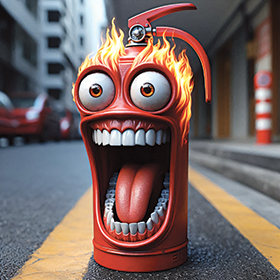

When was the last time you gave the fire extinguishers in your building more than a passing glance? While having a fire extinguisher on the wall may seem to indicate that you have fire safety covered, if it is a cheap imitation or has not been properly maintained, it is little more than decoration.
South Africa has clear fire safety regulations, and for good reason. Lives depend on it. According to SANS 10400-T, all fire extinguishers installed in buildings must meet the requirements set out in SANS 1910. The Pressure Equipment Regulations also prohibit the use of extinguishers that have not been manufactured or filled in accordance with these standards.
The rise of illegal fire extinguishers
Not every extinguisher on the market is the real deal. Some suppliers cut corners to save costs. They might use inferior powder, skip safety components, or affix a fake approval label to a cylinder that has not been properly certified. From the outside, you would not necessarily know. That is what makes it so risky.
So, how do you know if your extinguisher is actually compliant? There are a few key things you should always check:
• Certification marks: Only SABS, BSI (Kite Mark), or SACAS can certify extinguishers under SANS 1910. If the label does not show one of these, do not trust it.
• Powder quality: The extinguisher must contain SANS 1522-certified dry chemical powder. Anything less is a risk.
• Cylinder stamps: Every extinguisher must be permanently marked with the standard, manufacturer’s name, date, test pressure, and serial number.
• Label details: Look for the manufacturer’s information, working pressure, weight, fire rating, and hydrostatic test pressure. If anything is missing, it is not compliant.
• Valve check: The valve must include a safety pressure relief device and CE marking. Ask for the module certificate.
Servicing and reconditioning
It is not just about what you buy, it is also about who services it. Extinguishers must be serviced to original specs by SANS 1475-certified companies using SAQCC-registered technicians. Beware of fake labels of companies replacing the original manufacturer’s instruction label. The unit is not compliant if the company’s name is not on the manufacturer’s certification schedule.
It is easy to assume that a fire extinguisher is a fire extinguisher. But when lives, livelihoods, and legal liability are on the line, the details matter. So next time you walk past that red canister on the wall, ask yourself: Is it really up to standard? Because if it is not, it might not be there when you need it most.
SafeQuip offers a full range of SABS-certified fire extinguishers, whether you’re protecting a home, workshop, factory floor, or even a boat. Its stored pressure dry chemical powder (DCP) extinguishers are built to handle Class A, B, and C fires. And because not all fire risks are the same, they offer different powder grades to match the level of hazard you’re dealing with.
The SANS 1910:2022-approved Lith-Ex fire extinguisher range from SafeQuip carries NTA 8133:2021 (KIWA/POOO55865) test approval, which proves its lithium-ion battery fire extinguishing capability.
SafeQuip also supplies high-performance CO₂ extinguishers for electrical and flammable liquid fires, as well as specialised units such as wet chemical and foam extinguishers. All products are built to SANS 1475 standards for easy maintenance by SAQCC-qualified technicians. A full range of accessories and spares ensures complete fire protection from installation to servicing.
For more information contact SafeQuip,

© Technews Publishing (Pty) Ltd. | All Rights Reserved.